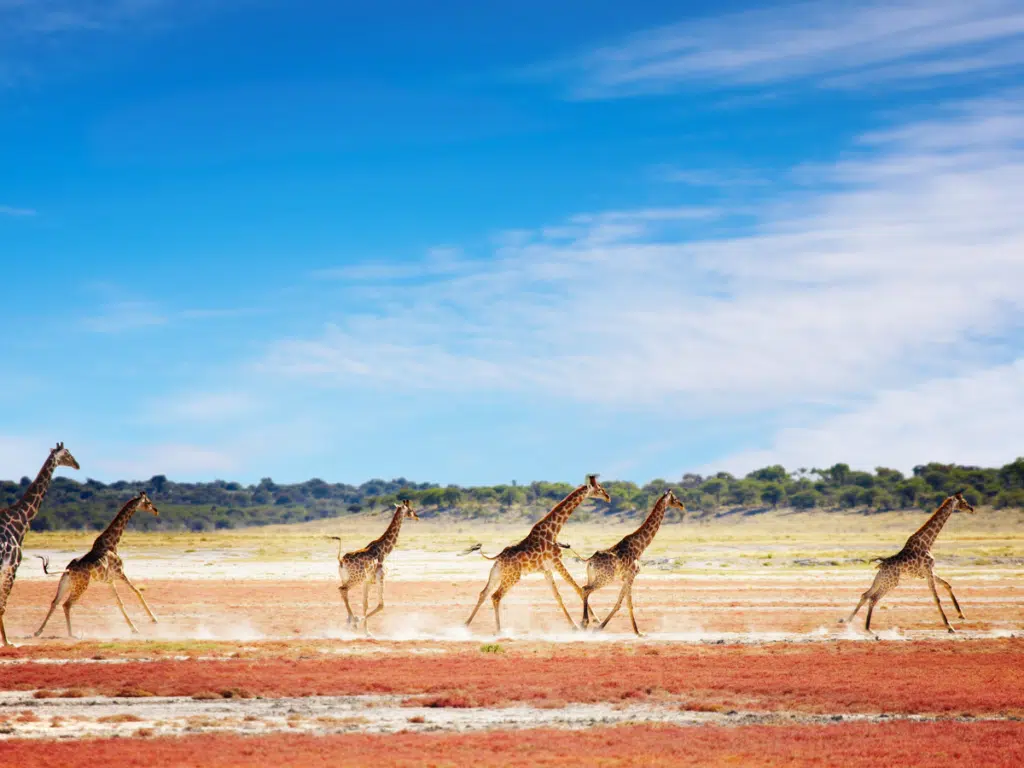Etosha National Park, Namibia: Ultimate Visitor’s Guide
One of the most popular destinations for travelers in Namibia, Etosha National Park is more than an amazing wildlife sanctuary or a spectacular game reserve. It is an area of outstanding natural beauty. In northwestern Namibia, Etosha National Park covers a huge expanse of land, around 22,270km², including unique salt pans that make for dramatic landscapes.
In this ultimate guide to Etosha National Park, you’ll learn about the park’s unique treasures and get all the details you need for your dream getaway to this breathtaking destination. Keep reading for details about how and when to visit Etosha National Park, where to stay in and around the park, and travel tips to make your travel experience at Etosha one you’ll never forget.

This post contains affiliate links that may reward me monetarily or otherwise when you use them to make qualifying purchases – at no cost to you. As an Amazon Associate, I earn from qualifying purchases. For more information, please read our disclosure policy.
Etosha National Park
Over thousands of years it has dried out, leaving salt and minerals where water once lay. The pan itself creates a dynamic panorama that is large enough to be seen from space.
During the dry season, it glimmers in hues of greens and becomes inhospitable for almost all wildlife. These animals then wander the park in search of a waterhole.
When the rainy season returns, so does much of the wildlife, including mammals, birds, and reptiles. It is the perfect place to catch a rare glimpse of the endangered black rhino.
It is from the flat, salt pan that Etosha gained its name, it means ‘Great White Place’
The Etosha pan is towards the northern region of the Namibian game park and is alongside wide-open grasslands and savannahs.
Here the Mopani and large camel thorn trees grow far enough apart that their branches and leaves don’t form a canopy. Instead, the sunlight can get easy access to the ground allowing lush green vegetation to grow.
Salt pans only cover 23% of the park. The rest is Savanna woodlands which provide plenty of vegetation to support the wildlife. It is hard to believe that you are in the middle of a desert when you’re surrounded by magnificent dunes and golden grassy plains.
Etosha National Park is easily accessible via one of four gates. These are the Andersson, Von Lindequist, Galton, and King Nehale Lya Mpingana Gates, which lie on varying borders of the park.
Etosha Park is traversed by a huge network of crisscrossed roads. This ensures that the majority of the park can be accessed with a regular vehicle. This is unlike so many other Namibian parks, accessible solely with a 4×4.
Etosha National Park Gate Fees
The gate you use to enter the park will depend on where you’re coming from and where you’re going in the park. All gates open at sunrise, and close at sunset.
All gate fees are charged per 24 hour period, starting at the time of entry. Unfortunately, you can’t pay for part of a day if you’ll only be in the park for a few hours. One 24 hour period is the minimum payment.
Here are the entrance fees plus the required conservation fee. They’re subject to change over time, so be sure to check the Namibia Wildlife Resorts (NWR) website before you travel for an update!
Foreign Adults: N$150 Children 8 – 16 yrs: N$100
SADC Adult Nationals: N$100 Children 8 – yrs: N$50
Namibian Adult Nationals: N$50 Children 0 -16 yrs: Free
All Children under 8 yrs: Free
Vehicles with 10 seats or less are charged an additional gate fee of N$50 per 24 hours.
These fees are payable by credit card. You will also be asked for your ID, so keep that handy!
Etosha National Park Camp Gate Times
Once you’re inside the park, the camps you stay in will have their own gates and gate times. All camp gates open and close at the same times, and these times change every Sunday, to keep up with the changing sunrise and sunset.
For example:
January 16 – 22 Open 6:35 am Close 7:40 pm
January 23 – 29 Open 6:40 am Close 7:40 pm
Open and close times are posted at all gates. Check times here to get an idea of gate times during your visit.

Accommodation in Etosha National Park, Namibia
There are 6 main camps in Etosha National Park. They offer true camping under canvas experiences through to total luxury with four-poster beds and room service.
Dolomite Camp
Luxuriously furnished safari-style tents are available in the camp that is set into the hill on the western side of the park. It offers amazing game sightings from the viewing deck overlooking the floodlit waterhole.
Onkoshi Camp
Wooden chalets that are built upon platforms offering an amazing view over the Salt Pan. During the dry season, there is the spectacle of the glimmering, mirage-like shimmers created by the pan. In the rainy season there is a delicious haze of pink from all of the gathering flamingos.
Okauluejo Camp
This is the busiest camp and it’s easy to see why. Guests have unrivaled views over one of the best spots, the Okauluejo waterhole. It is possible to see elephants, lions, and the occasional rhino quenching their thirst from the comfort of your chalet.
Halali Camp
Halali is central to the park and has the largest swimming pool. Its proximity to several busy waterholes is a draw for many tourists.
Namotoni Camp
A striking camp built from the remnants of a German Fort. Sit on the walls at dusk and enjoy a sundowner as you watch in awe at the many visitors to the King Nehale floodlit waterhole.
Olifantsrus Camp
The newest of all the campsites where you will get the opportunity to get closest to the African bush. All of the accommodation is made from canvas, enabling you to camp beneath the stars.
There are multiple places to stay on the outskirts of the camp should you prefer. Etosha village caters for many tourists each year. Many other camps are available offering bed and breakfast or lodges, all of which are based close to the 4 gated entrances.
Things To Do in Etosha National Park
Safari! A primary attraction in Etosha Park is the magnificent wildlife. There is nothing like seeing African wildlife in its natural habitat.
There are also many other activities available at the camps, like swimming pools, restaurants, shops and more! You can fill your time doing anything from relaxing by the pool or hiking around the camp.
Whatever you choose to do while visiting this beautiful park will be unforgettable. And don’t forget about all those incredible photos of wildlife that will make any photographer jealous!
This is one of the main attractions of the park, that it is so easily accessible. Whether you choose to self-drive or to take a fully guided tour, you can reach every corner of the park. You are virtually guaranteed to see some game.
There are even tours available with a designated professional photographer on board. They ensure everyone gets perfectly composed, stunning pictures.

Travel Tips for Etosha National Park
Etosha National Park in Namibia is one of the largest game reserves in Africa. As it can be a bit unnerving to see wild animals run around, there are a few safety tips that you should always keep in mind when visiting.
One thing that travelers often forget is to stay in your vehicle at all times. These are wild animals roaming free within the park. They can become aggressive or defensive if they feel threatened by humans. They will continue to approach as long as someone is close.
You could also end up with an animal running into your car while driving through their territory.
How Much Time do You Need to Visit Etosha National Park
Etosha National Park is Namibia’s most popular tourist attraction, and is home to Africa’s largest concentration of wildlife. It offers visitors the chance to see lions, elephants, giraffes, zebras and more in their natural habitat.
The park has many types of accommodation available from luxurious lodges to campsites. If you have time on your hands, then it would be worth spending at least two days exploring this amazing place.
I recommend that if you are going to spend any time in Etosha National Park, then make sure that one day is spent in each of the following areas – Okaukuejo Rest Camp, Halali Campsite, or Kwando River Lodge (if staying overnight).
You will need at least three days, however, four to five days would be better still! Remember not every day needs to be spent viewing animals. There are some great hikes around here too so don’t forget your walking shoes!
We spent 3 days and 2 nights in Etosha on our 10-day long Namibian trip. This is by far the best park we visited during our time there. We could have stayed longer as obviously there was so much more to see, but we photographed a plethora of wildlife while there.

Frequently Asked Questions
Can you see the Big 5 in Etosha?
Etosha is home to 4 of Africa’s Big 5 animals: the Cape Buffalo can not be found here. However, it is a great place to see rhinos! Both the white rhinos and black rhinos can commonly be spotted in the park.
In fact, Etosha has one of the most important black rhino populations in Africa. Chances are you will see more black rhinos than white while you’re here.
How many lions are in Etosha?
At last count, Etosha National Park was home to an estimated 750 lions. For some reason, the lions in the western part of the park are notorious for being especially ferocious.
Where can I see lions in Etosha?
Your best chance of seeing lions in Etosha park is near one of the waterholes. They come to drink and to spot any potential prey that might come to drink.
During the warmer parts of the day lions are often sleeping, and can often be seen napping under trees. Early mornings and late afternoons are prime times for lion sightings!
Is Etosha malaria free?
No, visiting Etosha Park does carry the risk of malaria. The risk depends on the number of mosquitoes, which varies with the time of year. The mosquito population is smallest during the dry season from May through October, so the malaria risk is lower.
Once November arrives and the wet season rolls in, the number of mosquitoes increases until around the end of April. This risk of malaria is greater during these wetter months.
Visit Etosha National Park
Open all year round, the Etosha National Park in Namibia is the perfect place to take a vacation. You could see hundreds of different species of mammals, birds, and reptiles in their natural habitat.
As long as you adhere to safety guidelines, families, couples, and lone travelers can self-drive. Or join a photo safari group to experience the wonders of Etosha. Return to camp in a range of accommodations to suit any budget.
After all, 200,000 visitors each year can’t be wrong!

Carley Rojas Avila is a bilingual New York-based travel writer, editor, content marketer, and the founder of the digital travel publications Explorers Away and Home to Havana. Carley is an expert on all things Latin America, the Caribbean, and Cuba, having lived and worked in four different countries in the region. Her writing has appeared on the Associated Press wires and in Travel + Leisure, Yahoo, MSN, Euronews, The Weather Channel, and more. When she's not writing about her travels, find her front row at a Bad Bunny concert, befriending street cats, and taste-testing every pizza in Havana.

